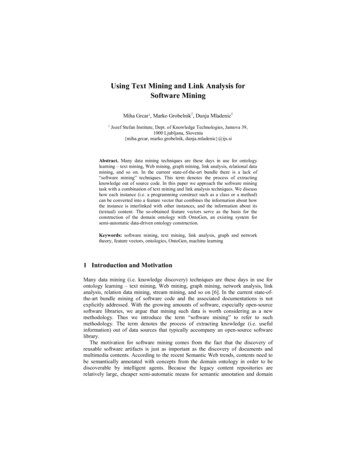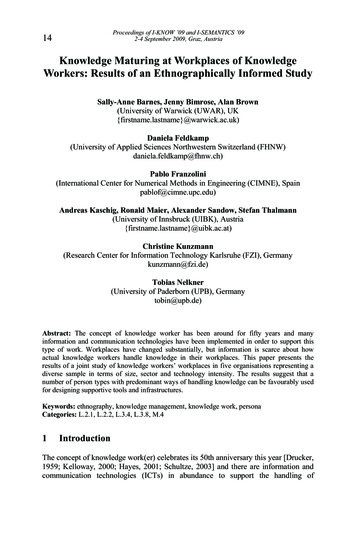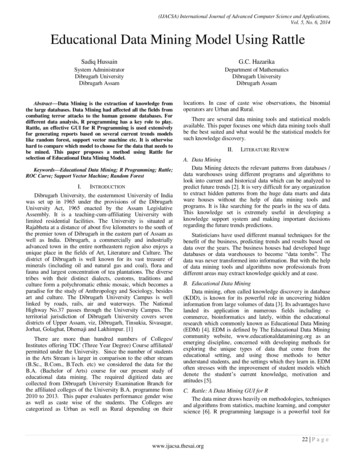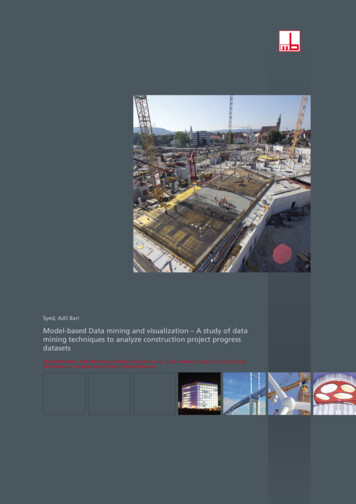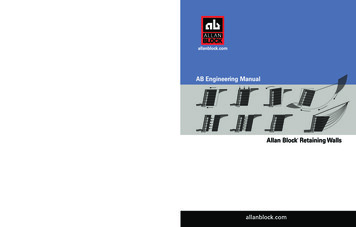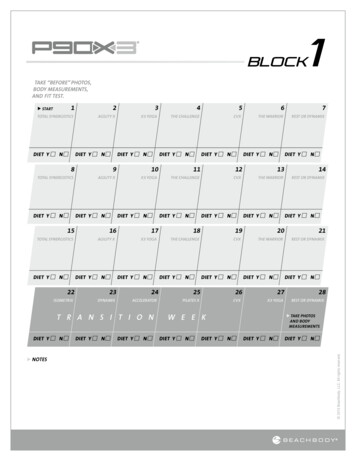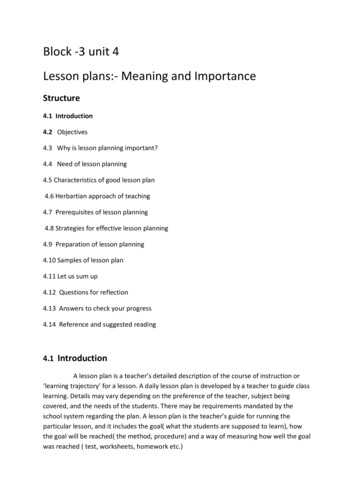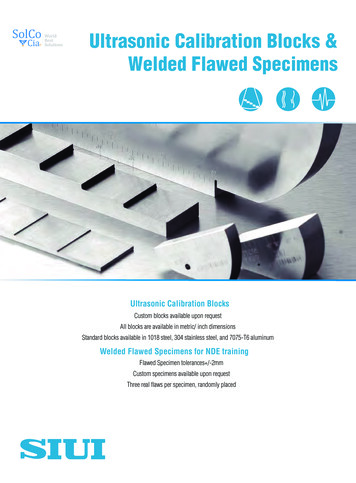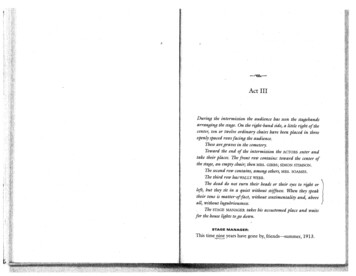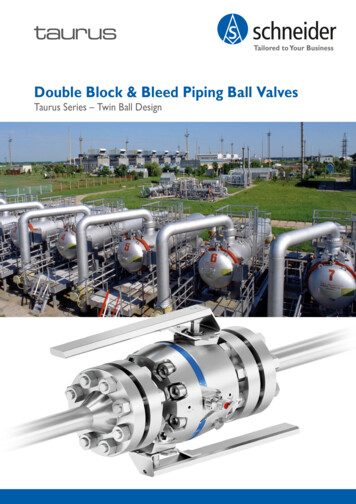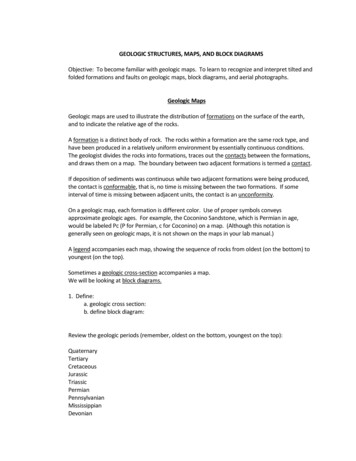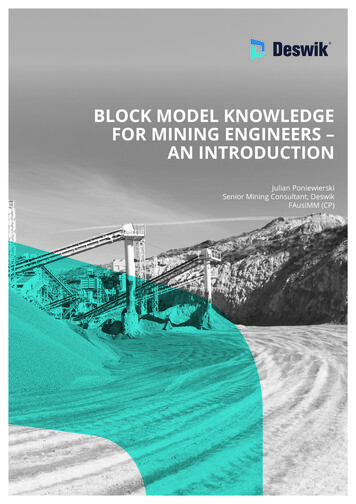
Transcription
BLOCK MODEL KNOWLEDGEFOR MINING ENGINEERS –AN INTRODUCTIONJulian PoniewierskiSenior Mining Consultant, DeswikFAusIMM (CP)
BLOCK MODEL KNOWLEDGE FOR MINING ENGINEERS – AN .2.Effect of SMU on a pit optimisation6.3. Advantages and disadvantages of using SMUfor dilution loss assessment25267.282.THE BASICS42.1.2.2.2.3.Model frameworkModel sub-divisionRotated models4553.BLOCK MODEL tamine – 04.BLOCK MODEL TYPES104.1.Inverse distance models4.2.Ordinary kriged models4.3.Linear vs non-linear methods4.4.MIK – Multiple Indicator Kriged models4.4.1.Some MIK terminology you need to know4.4.2.When you might see MIK used:4.4.3. Some important issues and limitations with MIK:4.4.4.How to use it in interrogations4.5. Localised indicator Kriging / Uniform conditioning4.6.Consim – Conditional Simulation models4.7.Gridded seam models4.8.Harp models1111111213131416171718195.20PROBLEMS TO BE COGNISANT OF5.1.Overview5.2.Some sources of error5.3.Insufficient data5.4. Lack of fundamental understandingof geological controls5.5.Selectivity – SMU – dilution – lossTHE CONCEPT OF AN SMUDILUTION AND LOSS25277.1.Overview7.2.Mark-out smoothing dilution/loss7.3. Dilution skin approach7.4. Outside of block model dilution techniques282829308. BEFORE YOU START USING THEBLOCK MODEL318.1.8.2.Understand your block modelBlock model checks before use31319.REFERENCES3220202122242
BLOCK MODEL KNOWLEDGE FOR MINING ENGINEERS – AN INTRODUCTION1. INTRODUCTIONAs a software provider for the mining industry,Deswik is regularly training mining engineers inthe use of our software in mine design, planningand scheduling.We are often called upon to train junior engineers enteringtheir first ever planning-related role and note that many ofthese engineers need and want more knowledge on theplanning processes beyond just how to use the software beingprovided. One of these requirements is knowledge on blockmodels that need to be used for the mine planning process.While the focus of this document is to introduce miningengineers to block models so that they have someunderstanding of what they are dealing with and to make surethey do not make mistakes from a lack of knowledge, it needsto always be kept in mind that the block model they havebeen given may not be appropriate for the task at hand. AsClive Johnson (B2Gold President and CEO), said in 2013 at aScotiabank Mining Conference panel discussion on the topic ofthe failings of NI 43-101 reports:“What we typically see where it falls apart [project value] is theblock model. We just say, give us your data. it usually fails rightthere. The extrapolation that they’re using for their reserves andresources is probably completely out of whack relative to thegeostatistical information or data that is there”.The rapid turn-over of personnel during the last mineralsboom, and then the loss of experienced technically-focusedpersonnel during the following bust means that many of thejunior engineers have no on-site mentor sufficiently technicallyskilled to provide suitable knowledgeable help to the juniormining engineers.So be wary, but boldly go forth fortified by knowledge.With these factors in mind, this document has been writtento introduce new mining engineers to mineral resource blockmodels: their structure, the brands they may come across, thetypes they may come across, and issues that they will need tounderstand to avoid mistakes in their use.www.linkedin.com/in/julianponiewierski/If you have constructive feedback for the improvement ofthis document, please feel free to contact the author atjulian.poniewierski@deswik.com.It is not the intention to turn mining engineers into resourcegeologists, but it is important that a mining engineer shouldalso be sufficiently conversant with the resource estimationprocedures to understand how the resource block model wasgenerated. A resource block model will only ever be as good asthe geological foundations upon which it is built.And as the resource block model is the foundation upon whichthe industry’s mine plans are built, our plans will only ever beas good as the geological block model that has been given tous to use.This document is merely a first-step introduction to theknowledge needed. We acknowledge that although this isintended to be an introduction to the topic, there is still alot that has been covered, so we invite the reader to "dip in"where required and skip over the parts not yet relevant totheir work. We also encourage the new mining engineer toread more on resource estimation beyond this document toenhance their knowledge base.3
BLOCK MODEL KNOWLEDGE FOR MINING ENGINEERS – AN INTRODUCTION2. THE BASICSA block model is a simplified representation of an ore bodyand its surroundings that can be thought of as a stack ofcomputer-generated “bricks” that represent small volumes ofrock in a deposit (ore and waste). Each “brick”, or cell, containsestimates of data, such as element grade, density and othergeological or engineering entity values.Figure 1: A block model of an ore body coloured by grade (shelland slice)The cells of a block model are arranged in an XYZ grid system,and the cells may be of uniform or of irregular size.Deswik software does not do grade estimations for thegeneration of block models, but allows for the interrogationand manipulation of a block model prepared by othersoftware packages, such as Leapfrog/Edge, Datamine, Vulcan,Surpac, MineSight and Micromine. In these packages, theblocks are assigned a grade by one of a number of differentestimation methods: Inverse Distance Squared, OrdinaryKriging, Multiple Indicator Kriging, and so forth.The following sections explain these concepts further.2.1. MODEL FRAMEWORKThe term “model framework” defines the rectangular region ofspace within which the model cells are located. It requires anorigin, distance for each axis, and rotation angle.Figure 2: Standard block model frameworkWithin this framework are individual blocks, all with adesignated length (X-increment), width (Y-increment), and height(Z-increment). The block position may be defined bya centroid (Xc, Yc, Zc), or a block origin (Xmin, Ymin, Zmin).Figure 3: Block model block definitionThe number of blocks in each coordinate axis direction isusually specified to define the full potential model framework.Note that some modeling schemes do not necessarily needa fully “filled” block model – blocks can be missing or absentwithin the framework.4
BLOCK MODEL KNOWLEDGE FOR MINING ENGINEERS – AN INTRODUCTIONFigure 4: Filled block modelFigure 6: Sub-celling of a block model along a boundaryThe sub-division process can be done in one of two ways:octree or flexible sub-division.One final and important aspect of block model frameworks isto note how blocks are positioned at the origin. There are twooptions as shown in Figure 5. The block format with the “originblock” sitting along the axes (left image in Figure 5) is the mostcommon, but the “origin block” having its centroid located onthe origin (right image in Figure 5) has to be checked for, asit will sometimes occur (Note that this is the default option inMicromine models).Figure 5: Potential block centroid to origin relationshipOctree sub-division splits the parent block into a hierarchy ofcubes with automatic sub-division at the boundaries beingused, so that all blocks are continually halved, resulting inblocks with sides of size “x”, “x/2”, “x/4”, “x/8”, “x/2n”, where“x” is the original maximum block size (parent block), and “n”indicates the maximum amount of sub-division to be allowed.This is the method Surpac uses.The flexible method allows sub-division to vary dependingupon the angle of intersection of a particular block withboundary surface controlling the sub-division. The subdivision is infinitely variable, allowing a better volumetricinterpretation of the boundary surface, producing fewerblocks for the same level of accuracy compared with theoctree method. This is the method Datamine uses.Surpac uses octree sub-division, whereas Datamine usesthe flexible method; this is a major cause of incompatibilityissues between the two types of models. (Note that Surpachas a “free block model” format to allow for the import andinterrogation of a Datamine model.)2.2. MODEL SUB-DIVISIONThe first models developed partitioned the total model spaceinto a regular three-dimensional lattice of cuboids as shownin Figure 4.In order to better model boundaries within the model space,the blocks can be sub-divided into smaller cuboid sizes(or rectangular prisms), known as sub-blocks or sub-cells,while keeping the storage and computational efficiency ofthe standard block model. The sub-cells are usually storedseparately from the parent blocks.2.3. ROTATED MODELSSome block modeling systems support rotated block models.A rotated model is one whose axes, and therefore cells, arerotated with respect to the coordinate system. It is particularlyuseful in the situation where a stratified ore body is dippingor plunging. The model cells provide a much better fit to theore body when the model is rotated, as can be seen from thefollowing figures.5
BLOCK MODEL KNOWLEDGE FOR MINING ENGINEERS – AN INTRODUCTIONIf this is your ore body shown in Figure 7:Figure 7: Cross-section of an ore body plunging obliquelyblock spatial positions when importing rotated block models,the centroid coordinates need to be supplied in eight- ornine-digit accuracy. Figure 10 shows two views of the blockintersection points of a rotated block model that was importedwith only two decimal accuracy. The result is a block modelwhere blocks overlap or have gaps (voids) between them.Figure 10: Close-up view of block corners of a rotated blockmodel imported with insufficient decimal accuracyThen, a normal orthogonal unrotated block model would endup with the ore blocks looking like those shown in Figure 8.Figure 8: Cross-section of an ore body plunging obliquely withunrotated blocksIf given data for a rotated block model with limited decimalaccuracy, it may be possible (if the model is a regularmodel and not an irregular sub-celled block model) tomathematically unrotate the model, correct the approximateunrotated centroids to what should be the true centroids (forexample an unrotated centroid of xx2.498673 was probablymeant to be xx2.500), and then re-rotate the correctedcentroids into a file ready for import into the software.3. BLOCK MODEL “BRANDS”The most common block model types encountered in themining industry are Datamine, Vulcan, Surpac, Micromine andMineSight.But if the block model is rotated, a much better representationof the ore body is possible with ore blocks looking like thoseshown in Figure 9.Figure 9: Cross-section of an ore body plunging obliquely withblocks rotated to Z-axisNote that in Datamine block models, the model is stored in anunrotated format and only rotated on display or interrogation.It is also important to note that in a rotated block model therotated centroid positions are not systematic simple centroidvalues anymore. To maintain any sort of accuracy in relativeDatamine format models are currently the best format foruse in Deswik as they are supported by extensive commandsfor interrogation and manipulations1. Given this, we havediscussed this file format more extensively than the otherformats.The Datamine format was the chosen format for Deswikwhen Deswik first started as we did not want to invent yetanother proprietary block model format, and the generalstructure and format of Datamine models was publiclyavailable and therefore well known. Many of the geologicalmodeling packages therefore support exporting their modelsas Datamine models. Other model formats have had to bedetermined by judicious trial and error interpretation of whatwe think is how they store their data.Deswik supports the direct import and conversion of Vulcanand Surpac models to Datamine format models. In addition,some basic functionality, such as solids interrogation intoDeswik.Sched is supported for Surpac and Vulcan modelsin their native format. But any model requiring furthercalculations and manipulations will need to be in the1A new block model format is being developed by Deswik to overcome many ofthe size, speed and storage limitations of Datamine and should be available in early2019. This file format will be compliant with the Open Mining Format (*.omf) formatrecommended by the Global Mining Guidelines Group (GMG).6
BLOCK MODEL KNOWLEDGE FOR MINING ENGINEERS – AN INTRODUCTIONDatamine format as the full suite of Deswik commands is onlysupported for Datamine models (and of course, for the new2019 block model format being developed).YmORIG)/YParentINCFor MineSight, Micromine and other unsupported modeltypes, the best solution to importing into Deswik is to directlyexport the block models from the originating software packageas Datamine format models. Alternatively, they can thenbe exported as CSV files, which can then be converted to aDatamine format model in Deswik.Where XParentINC, YParentINC and ZParentINC are the X, Yand Z sizes of the Parent Blocks (to any subcells).K ROUND[ (Zc-ZParentINC/2)/ZParentINC]*ZParentINC –ZmORIG)/ZParentINCThe model prototype structure uses the fields shown in Table 1.Table 1: Datamine block model prototype structure fieldsFieldsDescriptionXMORIG, YMORIG,ZMORIGXYZ origin of the model. Datamine sets the origin withrespect to the corner of the first parent cell and NOTits centroid.XINC, YINC, ZINCXYZ cell dimensions (increments).Datamine block models will be recognized by their suffix:*.dm.NX, NY, NZThere are two major limitations of Datamine files that need tobe understood:Number of model parent cells in XYZ. Datamine allowsa value of one for modeling seams. The number ofcells, in combination with the cell parent size, definesthe extent of the model dimensions.XC, YC, ZCXYZ cell cen
software packages, such as Leapfrog/Edge, Datamine, Vulcan, Surpac, MineSight and Micromine. In these packages, the blocks are assigned a grade by one of a number of different estimation methods: Inverse Distance Squared, Ordinary Kriging, Multiple Indicator Kriging, and so forth. The following sections explain these concepts further. 2.1. MODEL FRAMEWORK The term “model framework”
